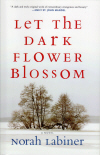Let the Dark Flower Blossom
In Norah Labiner’s Let the Dark Flower Blossom, the character Roman Stone, a writer, says, “A story is a map to the underworld and how you follow that map is, of course, entirely up to you.” This story is cut into different patterns of back-story and forward motion, and point of view shifts from first person to third, character to character. Stone, a celebrity novelist, has been murdered. The news is shocking but not really a surprise to the lovers, enemies, and friends who have revolved around him, seemingly helpless to get out of his orbit. What the reader learns about Stone comes from the retrospective memory of the others. He appears to be the monster in the center of the labyrinth.
In Norah Labiner’s Let the Dark Flower Blossom, the character Roman Stone, a writer, says, “A story is a map to the underworld and how you follow that map is, of course, entirely up to you.” This story is cut into different patterns of back-story and forward motion, and point of view shifts from first person to third, character to character. Stone, a celebrity novelist, has been murdered. The news is shocking but not really a surprise to the lovers, enemies, and friends who have revolved around him, seemingly helpless to get out of his orbit. What the reader learns about Stone comes from the retrospective memory of the others. He appears to be the monster in the center of the labyrinth.
Initially the exposition seems to take place behind a glass barrier. This is a self-conscious meta-fictional work about literary ambition, hidden evil, competition, and guilt. Its characters—writers, readers, and academics—exaggerate the self-consciousness. They constantly discuss: What is the story? Who owns the story? What are the rules of story-telling? Who breaks the rules? How does the story end? Is the novel dead, and who killed it?
Sheldon Schell and Eloise Sarasine are twins. Their history with Stone goes back to their freshman year in a small Midwestern college. They are fleeing tragedy: the death of their parents (possibly murder-suicide) and the destruction of their childhood home (possibly arson). Roman is rich, decadent, and upper class. Eloise becomes his lover, and Sheldon his roommate. Roman writes a precocious and successful novel on Sheldon’s typewriter, betraying his friend doubly by appropriating his story.
Sheldon’s is the voice that dominates. Later in life, he lives on an island in the Great Lakes as a failed novelist and hermit. Also on the island is an old doctor dying of dementia. Sheldon tells him over and over about his guilt, about crimes he may or may not have committed, about Stone’s betrayal knowing that each time, the old man will not remember.
I never wrote my story, no.
I told it again and again. Perfecting it—
To Dr. Lemon.
Infecting him with the sickness of the words.
He is thrown into a crisis when another writer ferrets him out on his island to plunder his knowledge of Stone and to rehash the story yet again. Schell slowly undermines his own reliability as details are revealed about a murder/rape of a hitchhiker involving the two roommates in a winter landscape long ago.
Eloise is a wife in a doll’s house with her lawyer husband, Louie, who makes his living undermining the credibility of memory in the courtroom. Her dialogue and thoughts are interwoven with literary references. “Eloise looked up from her horoscope in the newspaper. ‘Snow is general,’ she said.” She sleepwalks through her upper-middle-class life as she recalls the past, sifting through, and avoiding and confronting facts.
Her rooms were quiet. In her coffee, she stirred cream and spooned sugar. Snow fell and was falling. . . . And though she had certain theories about why the caged bird sings, she was undecided as to whether existence preceded essence. Or why it so happened that year by year, as there was more to her, there was less and less of her.
She starts an affair with her first husband, Zigoullier. Susu, Eloise’s daughter from that marriage, runs off with Stone despite the possible efforts of her mother to protect her from being drawn into his web. It is Sheldon who introduces Susu and Stone. Susu speaks to the reader in the aftermath of her affair with Roman, in an unspecified Mediterranean location.
He told me a story. It was not a story. . . . It was a body. It was not a body. It was the chalk outline around a body. It was not a story. . . . And the last morning on an ancient island with the birds and oranges . . . he asked me if I believed him. We stood on the balcony, he scattered bread, and he told me that when it came round to it, I would turn against him.
A soap-operatic tangle of incest, betrayal, and revenge unravels, involving Susu, Eloise, her first lover, Roman, and Zigoullier. Eloise may be the conscience of the “story” when she speaks the line that gives the novel its title, a reference, perhaps, to Hawthorne in The Scarlet Letter: “It is our fate. Let the black flower blossom as it may.”
Labiner’s writing has a perseverative quality, like an incantation. The reader has to spend much energy determining the nature of the game, but this effort pays off as the intrigue deepens. Story and memory become characters in their own right, malleable and unreliable. The novel is either a map or a maze that leads into a fractured gothic tale of guilt, crime, and the distortions of reality and memory.





